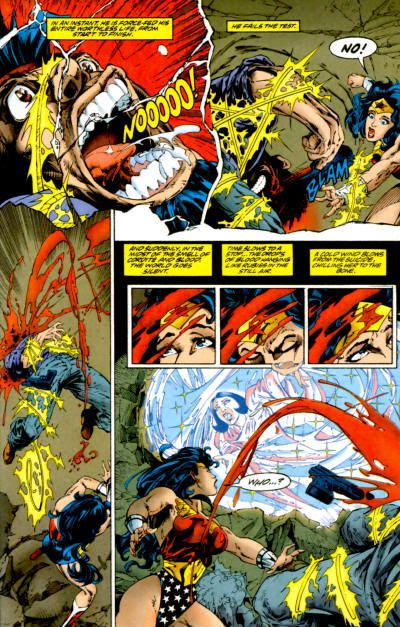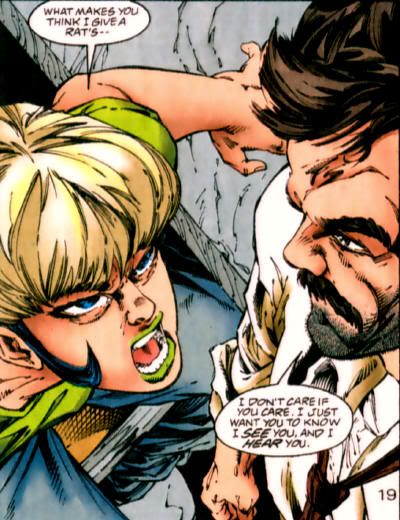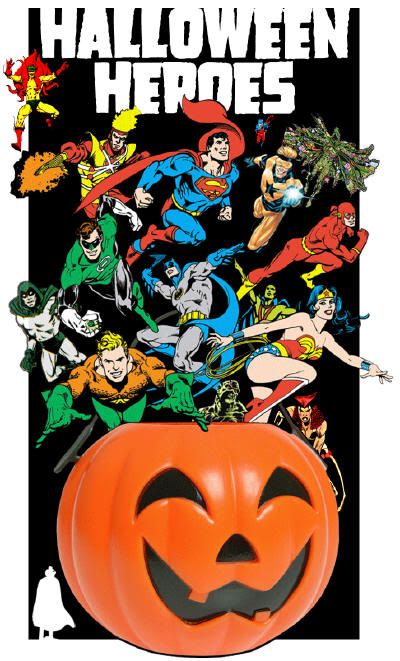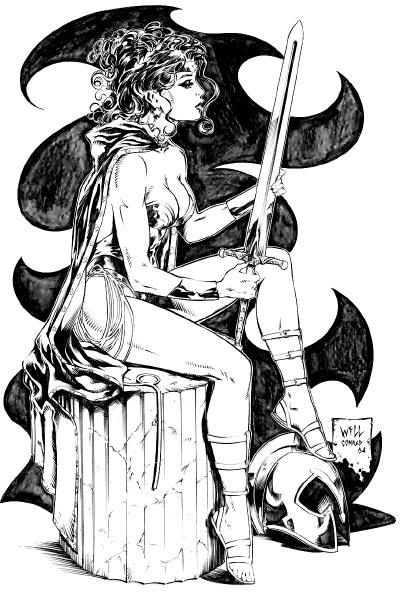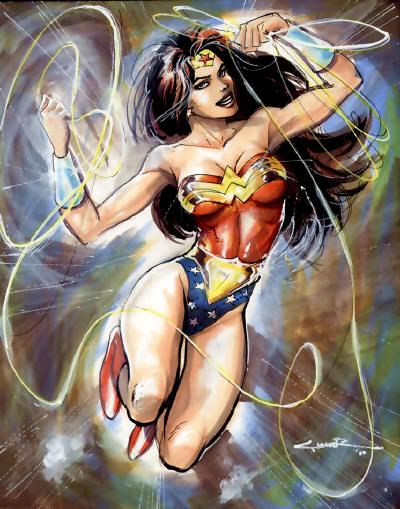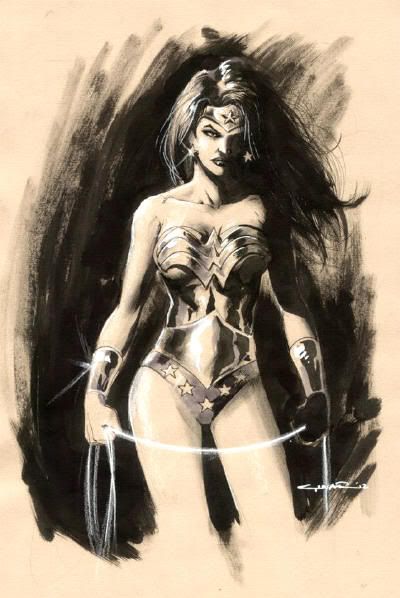
After several years as a de-powered urban adventurer in contemporary fashions, Diana Prince went back to being Princess Diana of Paradise Island in 1973. As part of the issue celebrating the rebirth of the costumed heroine Wonder Woman, a new character of seemingly great import was introduced. An armored warrior who appeared to be Diana's equal or better (taking into account that the Amazing Amazon was probably a bit rusty at super-battles) laid claim to the title of Wonder Woman.

Wonder Woman and her challenger began a contest at Paradise Island Stadium involving grabbing charging bulls by the horns and a sword fight in which the pair were tethered by their non-dominant wrists (the plaintiff was left-handed.) Diana was on her back and threatened with a deathblow, but her opponent hesitated, allowing Wonder Woman to deflect her sword and force a draw. Queen Hippolyta then bade the stranger remove her helmet to reveal herself. "I am Nubia! Wonder Woman of the Floating Island!"

It was soon revealed in a spectacularly blatant retcon that this was Nubia, Diana's literal soul sister sculpted from dark clay at the same time as Diana at the command of the goddess Aphrodite ("Afrodite?") Nubia was blessed by the goddesses as Diana was, and meant to be raised as her twin, until she was kidnapped in infancy by the war god Mars. Nubia was then raised to become Diana's adversary, and usurp her role as the champion of the Amazons.

"The Mystery of Nubia" was a five page solo back-up strip in the following issue that revealed the Floating Island seemed to be populated almost entirely by African tribesmen with spears and shields living in thatch huts. They dressed nearly identically, and engaged in mortal combat under Mars' law for the right to become Princess Nubia's mate. This Wonder Woman wished to be no man's possession, so when Goolah lost his match, Nubia fought the near-victor Kenyah for her own liberty. The match ended with Nubia's sword jammed into the ground inches from Kenyah's face. "A woman doesn't destroy life-- she cherishes it! She never forgets that once a life has been taken-- it can never return! Until men turn from war to peace-- and violence to love-- they will always remain in a murderous jungle!" Nubia then returned to her hut to cry in a "bottomless sea of loneliness."

In her final major appearance in her original incarnation, Nubia's full origin was revealed. The Floating Island was actually Mars' Slaughter Island, a mobile base with a volcano that could fire molten rock like cannonballs, which targeted Paradise Island. Princess Diana soon arrived to plug it up, but she was then tricked by the island's seeming ability to conjure illusions. Diana was set upon by a whole band of the island's warriors, who were defeated in short order. However, she was struck from behind by Nubia, and the two women began a protracted battle.

Diana recognized a ring Nubia wore from an experience in her youth that associated the jewelry with Mars. Wonder Woman flew her adversary high enough in the sky that reflected beams from the sun caused the ring to expand and fall off Nubia's finger. Despite being raised from birth to be Mars' instrument of vengeance against the Amazons, Nubia could only be fully controlled through the power of the ring, and immediately turned on her former master. Mars tried to ward the heroines off with an illusory monster, but was ultimately framed as a coward too terrified to attack the Amazons directly, and abandoned his assault now that he no longer had Nubia to do his dirty work.

Clearly, Nubia should have either become one of the great Wonder Woman foes, or her staunchest ally. You have to remember, when Wonder Girl was created, she was supposed to be Diana as a teenager. A mistake led to her joining the Teen Titans, and developing into an entirely separate being named Donna Troy. Wonder Girl was treated as a Titans character first, and was very much extant for most of her shared history with Wonder Woman. Steve Trevor was dead, Etta Candy forgotten, and there wasn't much in the way of prominent Amazons. Even if there had been, Diana Prince's sole companion for years was I-Ching, who was killed off in the very issue introducing Nubia. Beyond Queen Hippolyte, Wonder Woman was starting off with a blank slate in the supporting cast department.

Further, Wonder Woman hadn't dealt with her better known rogues in years, many were quite dated by the '70s, and they'd have to be reintroduced to readers. Meanwhile, Nubia had just appeared on a pair of fantastic, memorably covers and a story of some magnitude. By 1975, Nubia was set to be played by Teresa Graves, the first African-American actress to star in an hour long drama in the U.S., on the hit Wonder Woman television show. Nubia was introduced as "Wonder Woman's super-foe" as part of Mego's line of tie-in dolls, and the only opponent created for that set. She was the only "African" DC character to appear in the well-loved Mego line, and was only joined by The Falcon if you count the entire Marvel line, as well. Friend or enemy, Nubia was all set to be a big deal and a lasting addition to the Amazing Amazon's lore.

Or not. The Nubia character was dropped from the TV show before she was ever introduced after it made a switch in network and time period. The closest she ever came to television was commercials for the toys. The comic book character had a tainted origin where she was raised on an island of stereotypical tribesman, then had to defend her chastity and right to self-determination at sword point. Nubia was terribly lonely, and only fought Wonder Woman because of some evil spell instead of her own intentions. When Nubia appeared in a Supergirl story late in the year of her debut, she was depicted as Hipployta's "other" daughter who was incapable of protecting her long lost mother from radioactive sea mutants before falling victim to their poisonous bite. While Nubia convalesced, Hippolyta made a big show of adopting their mutual savior Supergirl as her (latest) new daughter. Nubia was dying, and in the absence of Wonder Woman (who was out of contact on a mission,) it was up to Supergirl to save her life a second time. Nubia spends most of the story laid up and entirely dependent on the kindness of blonde white women.

Six years later, when she was gifted a one page cameo in a Super Friends comic, she was made the leader of an African village. Why? She was raised by a Greek god on a traveling island. Oh wait, she's "Nubia," so she's off to Africa then. There, she fought a Wonder Woman driven temporarily power-mad by a villain, but the outcome of their fight was never revealed, and Nubia wasn't so much as mentioned again for two decades. Where was her grieving mother? Her welcoming sister? How does a warrior who could fight Wonder Woman to a standstill and had her own doll be allowed to be forgotten so swiftly and completely?

When Nubia finally was plucked from the deepest depths of obscurity, it was as part of a series of annuals called "JLApe" where the Justice League fought Grodd and his Gorilla City minions to reverse their becoming apes. No weird racial overtones there. Bypassing the obvious pun of rebranding her "Negress," the Post-Crisis "Nu'Bia" passed through a formidable egress into the bowels of Themyscira to defend Doom's Doorway from the inside. So wait, the negra Amazon is locked up in the cellar for centuries, essentially enduring hell while committing no crime, and only pokes her head out to fight monkeys? Merciful Minerva! A follow-up two-parter drawn by probably the least suitable artist for a
Wonder Woman comic ever (the vulgar Irish comedian John McCrea) tied Nu'Bia into Zoroastrianism and saw her devote her life to resurrecting her godly boyfriend Ahura Mazda. This of course happened only after Joe Linsner had popularized Zoroastrianism (such as could be expected) through his
Dawn series, so the premise was both derivative and a blow to feminism. As an added bonus, it was the brainchild of African-American writer Doselle Young, best known for alienating
The Authority readers with his funky attempted spin-off
The Monarchy alongside McCrea. I can't recall which came first, but nobody much dug either.

How did Nubia go from being the great character find of 1973 to a cautionary tale? Being published by DC Comics in the 1970s couldn't have helped, where
Black Lightning couldn't survive a year when Luke Cage made it a decade, and
The Vixen never got published at all (to this day!) Nubia's creators made a mess out of her origin and motivations coming out of the gate, and allowed her to immediately stall out. It's a shame, because Nubia had such potential to be the Wonder Woman for people of color, arriving just a year after Green Lantern John Stewart (and long before he was making regular appearances.) The Vixen hadn't even been created for her aborted pilot issue, so Nubia is arguably DC's first "African" heroine, not that you'd know it from her absence of stature.

Wonder Woman is a character that comes with a lot of baggage and forced regulations, where Nubia offers the opportunity to write a Wonder Woman with much greater freedom to experiment. Nubia could have been a sweet aspirational character, and in a world where Beyoncé Knowles was a serious contender to play Princess Diana in a movie, the character still has an audience in the waiting. Given how distastefully Diana has been handled in recent years, I'd vastly prefer some Nubia myself, either by taking up the sword chopping so that Diana could get back to her magic lasso or by assuming the role of peaceful ambassador that extreme portrayals have forced Diana to abandon. In the 21st Century, in order to reflect a black female audience hungry for heroism in swiftly expanding media platforms, DC Comics needs Nubia now more than ever.
Post-Racial DC Comics?
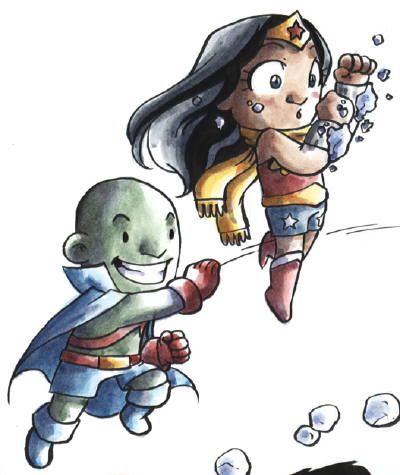

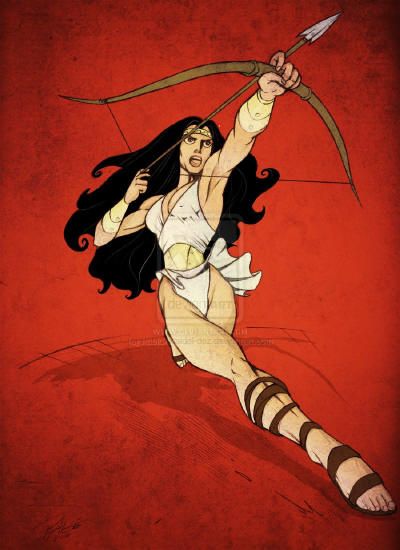
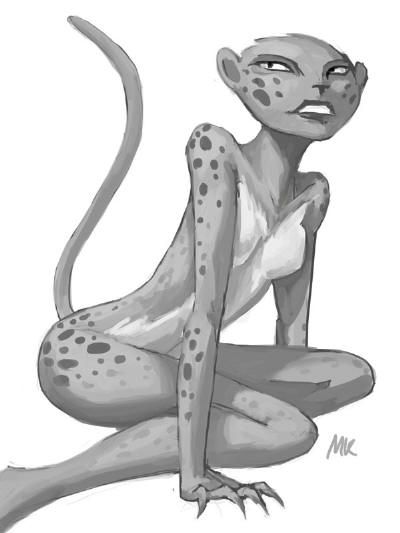
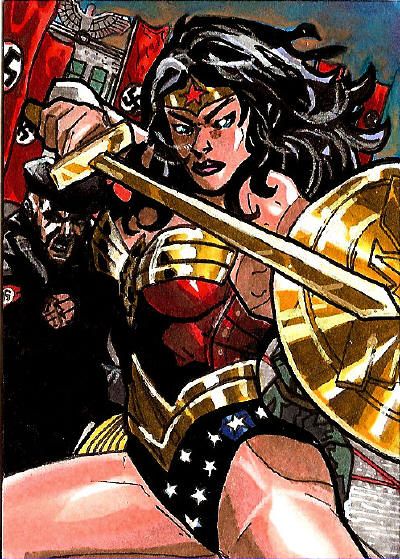











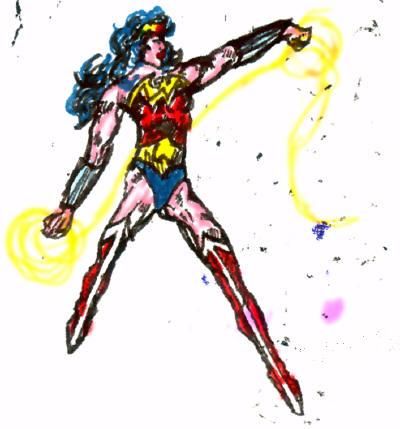 In the wake of "Reign of the Superman" and "Knightfall," I became fixated on my own design revamps of iconic DC heroes. I would do pages and pages of quasi-stick figure revisions in marker, and have sometimes featured them on my Martian Manhunter blog. Such an over-sharing occurred today, and since one of my Wonder Woman attempts was on the same page, I thought I'd crop it to spotlight here. Forgive the dismal quality, but depending on your viewing platform, the image is larger than original size. The elongated bracelets turned up in the Byrne period, and Perez did the thigh high boots on occasion in his day. Nothing new here, not even the basic image, which I believe I swiped from a Sal Velluto drawing.
Speaking of which, you might get a mild kick out of my
In the wake of "Reign of the Superman" and "Knightfall," I became fixated on my own design revamps of iconic DC heroes. I would do pages and pages of quasi-stick figure revisions in marker, and have sometimes featured them on my Martian Manhunter blog. Such an over-sharing occurred today, and since one of my Wonder Woman attempts was on the same page, I thought I'd crop it to spotlight here. Forgive the dismal quality, but depending on your viewing platform, the image is larger than original size. The elongated bracelets turned up in the Byrne period, and Perez did the thigh high boots on occasion in his day. Nothing new here, not even the basic image, which I believe I swiped from a Sal Velluto drawing.
Speaking of which, you might get a mild kick out of my  After several years as a de-powered urban adventurer in contemporary fashions, Diana Prince went back to being Princess Diana of Paradise Island in 1973. As part of the issue celebrating the rebirth of the costumed heroine Wonder Woman, a new character of seemingly great import was introduced. An armored warrior who appeared to be Diana's equal or better (taking into account that the Amazing Amazon was probably a bit rusty at super-battles) laid claim to the title of Wonder Woman.
After several years as a de-powered urban adventurer in contemporary fashions, Diana Prince went back to being Princess Diana of Paradise Island in 1973. As part of the issue celebrating the rebirth of the costumed heroine Wonder Woman, a new character of seemingly great import was introduced. An armored warrior who appeared to be Diana's equal or better (taking into account that the Amazing Amazon was probably a bit rusty at super-battles) laid claim to the title of Wonder Woman.
 Wonder Woman and her challenger began a contest at Paradise Island Stadium involving grabbing charging bulls by the horns and a sword fight in which the pair were tethered by their non-dominant wrists (the plaintiff was left-handed.) Diana was on her back and threatened with a deathblow, but her opponent hesitated, allowing Wonder Woman to deflect her sword and force a draw. Queen Hippolyta then bade the stranger remove her helmet to reveal herself. "I am Nubia! Wonder Woman of the Floating Island!"
Wonder Woman and her challenger began a contest at Paradise Island Stadium involving grabbing charging bulls by the horns and a sword fight in which the pair were tethered by their non-dominant wrists (the plaintiff was left-handed.) Diana was on her back and threatened with a deathblow, but her opponent hesitated, allowing Wonder Woman to deflect her sword and force a draw. Queen Hippolyta then bade the stranger remove her helmet to reveal herself. "I am Nubia! Wonder Woman of the Floating Island!"
 It was soon revealed in a spectacularly blatant retcon that this was Nubia, Diana's literal soul sister sculpted from dark clay at the same time as Diana at the command of the goddess Aphrodite ("Afrodite?") Nubia was blessed by the goddesses as Diana was, and meant to be raised as her twin, until she was kidnapped in infancy by the war god Mars. Nubia was then raised to become Diana's adversary, and usurp her role as the champion of the Amazons.
It was soon revealed in a spectacularly blatant retcon that this was Nubia, Diana's literal soul sister sculpted from dark clay at the same time as Diana at the command of the goddess Aphrodite ("Afrodite?") Nubia was blessed by the goddesses as Diana was, and meant to be raised as her twin, until she was kidnapped in infancy by the war god Mars. Nubia was then raised to become Diana's adversary, and usurp her role as the champion of the Amazons.
 "The Mystery of Nubia" was a five page solo back-up strip in the following issue that revealed the Floating Island seemed to be populated almost entirely by African tribesmen with spears and shields living in thatch huts. They dressed nearly identically, and engaged in mortal combat under Mars' law for the right to become Princess Nubia's mate. This Wonder Woman wished to be no man's possession, so when Goolah lost his match, Nubia fought the near-victor Kenyah for her own liberty. The match ended with Nubia's sword jammed into the ground inches from Kenyah's face. "A woman doesn't destroy life-- she cherishes it! She never forgets that once a life has been taken-- it can never return! Until men turn from war to peace-- and violence to love-- they will always remain in a murderous jungle!" Nubia then returned to her hut to cry in a "bottomless sea of loneliness."
"The Mystery of Nubia" was a five page solo back-up strip in the following issue that revealed the Floating Island seemed to be populated almost entirely by African tribesmen with spears and shields living in thatch huts. They dressed nearly identically, and engaged in mortal combat under Mars' law for the right to become Princess Nubia's mate. This Wonder Woman wished to be no man's possession, so when Goolah lost his match, Nubia fought the near-victor Kenyah for her own liberty. The match ended with Nubia's sword jammed into the ground inches from Kenyah's face. "A woman doesn't destroy life-- she cherishes it! She never forgets that once a life has been taken-- it can never return! Until men turn from war to peace-- and violence to love-- they will always remain in a murderous jungle!" Nubia then returned to her hut to cry in a "bottomless sea of loneliness."
 In her final major appearance in her original incarnation, Nubia's full origin was revealed. The Floating Island was actually Mars' Slaughter Island, a mobile base with a volcano that could fire molten rock like cannonballs, which targeted Paradise Island. Princess Diana soon arrived to plug it up, but she was then tricked by the island's seeming ability to conjure illusions. Diana was set upon by a whole band of the island's warriors, who were defeated in short order. However, she was struck from behind by Nubia, and the two women began a protracted battle.
In her final major appearance in her original incarnation, Nubia's full origin was revealed. The Floating Island was actually Mars' Slaughter Island, a mobile base with a volcano that could fire molten rock like cannonballs, which targeted Paradise Island. Princess Diana soon arrived to plug it up, but she was then tricked by the island's seeming ability to conjure illusions. Diana was set upon by a whole band of the island's warriors, who were defeated in short order. However, she was struck from behind by Nubia, and the two women began a protracted battle.
 Diana recognized a ring Nubia wore from an experience in her youth that associated the jewelry with Mars. Wonder Woman flew her adversary high enough in the sky that reflected beams from the sun caused the ring to expand and fall off Nubia's finger. Despite being raised from birth to be Mars' instrument of vengeance against the Amazons, Nubia could only be fully controlled through the power of the ring, and immediately turned on her former master. Mars tried to ward the heroines off with an illusory monster, but was ultimately framed as a coward too terrified to attack the Amazons directly, and abandoned his assault now that he no longer had Nubia to do his dirty work.
Diana recognized a ring Nubia wore from an experience in her youth that associated the jewelry with Mars. Wonder Woman flew her adversary high enough in the sky that reflected beams from the sun caused the ring to expand and fall off Nubia's finger. Despite being raised from birth to be Mars' instrument of vengeance against the Amazons, Nubia could only be fully controlled through the power of the ring, and immediately turned on her former master. Mars tried to ward the heroines off with an illusory monster, but was ultimately framed as a coward too terrified to attack the Amazons directly, and abandoned his assault now that he no longer had Nubia to do his dirty work.
 Clearly, Nubia should have either become one of the great Wonder Woman foes, or her staunchest ally. You have to remember, when Wonder Girl was created, she was supposed to be Diana as a teenager. A mistake led to her joining the Teen Titans, and developing into an entirely separate being named Donna Troy. Wonder Girl was treated as a Titans character first, and was very much extant for most of her shared history with Wonder Woman. Steve Trevor was dead, Etta Candy forgotten, and there wasn't much in the way of prominent Amazons. Even if there had been, Diana Prince's sole companion for years was I-Ching, who was killed off in the very issue introducing Nubia. Beyond Queen Hippolyte, Wonder Woman was starting off with a blank slate in the supporting cast department.
Clearly, Nubia should have either become one of the great Wonder Woman foes, or her staunchest ally. You have to remember, when Wonder Girl was created, she was supposed to be Diana as a teenager. A mistake led to her joining the Teen Titans, and developing into an entirely separate being named Donna Troy. Wonder Girl was treated as a Titans character first, and was very much extant for most of her shared history with Wonder Woman. Steve Trevor was dead, Etta Candy forgotten, and there wasn't much in the way of prominent Amazons. Even if there had been, Diana Prince's sole companion for years was I-Ching, who was killed off in the very issue introducing Nubia. Beyond Queen Hippolyte, Wonder Woman was starting off with a blank slate in the supporting cast department.
 Further, Wonder Woman hadn't dealt with her better known rogues in years, many were quite dated by the '70s, and they'd have to be reintroduced to readers. Meanwhile, Nubia had just appeared on a pair of fantastic, memorably covers and a story of some magnitude. By 1975, Nubia was set to be played by Teresa Graves, the first African-American actress to star in an hour long drama in the U.S., on the hit Wonder Woman television show. Nubia was introduced as "Wonder Woman's super-foe" as part of Mego's line of tie-in dolls, and the only opponent created for that set. She was the only "African" DC character to appear in the well-loved Mego line, and was only joined by The Falcon if you count the entire Marvel line, as well. Friend or enemy, Nubia was all set to be a big deal and a lasting addition to the Amazing Amazon's lore.
Further, Wonder Woman hadn't dealt with her better known rogues in years, many were quite dated by the '70s, and they'd have to be reintroduced to readers. Meanwhile, Nubia had just appeared on a pair of fantastic, memorably covers and a story of some magnitude. By 1975, Nubia was set to be played by Teresa Graves, the first African-American actress to star in an hour long drama in the U.S., on the hit Wonder Woman television show. Nubia was introduced as "Wonder Woman's super-foe" as part of Mego's line of tie-in dolls, and the only opponent created for that set. She was the only "African" DC character to appear in the well-loved Mego line, and was only joined by The Falcon if you count the entire Marvel line, as well. Friend or enemy, Nubia was all set to be a big deal and a lasting addition to the Amazing Amazon's lore.
 Or not. The Nubia character was dropped from the TV show before she was ever introduced after it made a switch in network and time period. The closest she ever came to television was commercials for the toys. The comic book character had a tainted origin where she was raised on an island of stereotypical tribesman, then had to defend her chastity and right to self-determination at sword point. Nubia was terribly lonely, and only fought Wonder Woman because of some evil spell instead of her own intentions. When Nubia appeared in a Supergirl story late in the year of her debut, she was depicted as Hipployta's "other" daughter who was incapable of protecting her long lost mother from radioactive sea mutants before falling victim to their poisonous bite. While Nubia convalesced, Hippolyta made a big show of adopting their mutual savior Supergirl as her (latest) new daughter. Nubia was dying, and in the absence of Wonder Woman (who was out of contact on a mission,) it was up to Supergirl to save her life a second time. Nubia spends most of the story laid up and entirely dependent on the kindness of blonde white women.
Or not. The Nubia character was dropped from the TV show before she was ever introduced after it made a switch in network and time period. The closest she ever came to television was commercials for the toys. The comic book character had a tainted origin where she was raised on an island of stereotypical tribesman, then had to defend her chastity and right to self-determination at sword point. Nubia was terribly lonely, and only fought Wonder Woman because of some evil spell instead of her own intentions. When Nubia appeared in a Supergirl story late in the year of her debut, she was depicted as Hipployta's "other" daughter who was incapable of protecting her long lost mother from radioactive sea mutants before falling victim to their poisonous bite. While Nubia convalesced, Hippolyta made a big show of adopting their mutual savior Supergirl as her (latest) new daughter. Nubia was dying, and in the absence of Wonder Woman (who was out of contact on a mission,) it was up to Supergirl to save her life a second time. Nubia spends most of the story laid up and entirely dependent on the kindness of blonde white women.
 Six years later, when she was gifted a one page cameo in a Super Friends comic, she was made the leader of an African village. Why? She was raised by a Greek god on a traveling island. Oh wait, she's "Nubia," so she's off to Africa then. There, she fought a Wonder Woman driven temporarily power-mad by a villain, but the outcome of their fight was never revealed, and Nubia wasn't so much as mentioned again for two decades. Where was her grieving mother? Her welcoming sister? How does a warrior who could fight Wonder Woman to a standstill and had her own doll be allowed to be forgotten so swiftly and completely?
Six years later, when she was gifted a one page cameo in a Super Friends comic, she was made the leader of an African village. Why? She was raised by a Greek god on a traveling island. Oh wait, she's "Nubia," so she's off to Africa then. There, she fought a Wonder Woman driven temporarily power-mad by a villain, but the outcome of their fight was never revealed, and Nubia wasn't so much as mentioned again for two decades. Where was her grieving mother? Her welcoming sister? How does a warrior who could fight Wonder Woman to a standstill and had her own doll be allowed to be forgotten so swiftly and completely?
 When Nubia finally was plucked from the deepest depths of obscurity, it was as part of a series of annuals called "JLApe" where the Justice League fought Grodd and his Gorilla City minions to reverse their becoming apes. No weird racial overtones there. Bypassing the obvious pun of rebranding her "Negress," the Post-Crisis "Nu'Bia" passed through a formidable egress into the bowels of Themyscira to defend Doom's Doorway from the inside. So wait, the negra Amazon is locked up in the cellar for centuries, essentially enduring hell while committing no crime, and only pokes her head out to fight monkeys? Merciful Minerva! A follow-up two-parter drawn by probably the least suitable artist for a Wonder Woman comic ever (the vulgar Irish comedian John McCrea) tied Nu'Bia into Zoroastrianism and saw her devote her life to resurrecting her godly boyfriend Ahura Mazda. This of course happened only after Joe Linsner had popularized Zoroastrianism (such as could be expected) through his Dawn series, so the premise was both derivative and a blow to feminism. As an added bonus, it was the brainchild of African-American writer Doselle Young, best known for alienating The Authority readers with his funky attempted spin-off The Monarchy alongside McCrea. I can't recall which came first, but nobody much dug either.
When Nubia finally was plucked from the deepest depths of obscurity, it was as part of a series of annuals called "JLApe" where the Justice League fought Grodd and his Gorilla City minions to reverse their becoming apes. No weird racial overtones there. Bypassing the obvious pun of rebranding her "Negress," the Post-Crisis "Nu'Bia" passed through a formidable egress into the bowels of Themyscira to defend Doom's Doorway from the inside. So wait, the negra Amazon is locked up in the cellar for centuries, essentially enduring hell while committing no crime, and only pokes her head out to fight monkeys? Merciful Minerva! A follow-up two-parter drawn by probably the least suitable artist for a Wonder Woman comic ever (the vulgar Irish comedian John McCrea) tied Nu'Bia into Zoroastrianism and saw her devote her life to resurrecting her godly boyfriend Ahura Mazda. This of course happened only after Joe Linsner had popularized Zoroastrianism (such as could be expected) through his Dawn series, so the premise was both derivative and a blow to feminism. As an added bonus, it was the brainchild of African-American writer Doselle Young, best known for alienating The Authority readers with his funky attempted spin-off The Monarchy alongside McCrea. I can't recall which came first, but nobody much dug either.
 How did Nubia go from being the great character find of 1973 to a cautionary tale? Being published by DC Comics in the 1970s couldn't have helped, where Black Lightning couldn't survive a year when Luke Cage made it a decade, and The Vixen never got published at all (to this day!) Nubia's creators made a mess out of her origin and motivations coming out of the gate, and allowed her to immediately stall out. It's a shame, because Nubia had such potential to be the Wonder Woman for people of color, arriving just a year after Green Lantern John Stewart (and long before he was making regular appearances.) The Vixen hadn't even been created for her aborted pilot issue, so Nubia is arguably DC's first "African" heroine, not that you'd know it from her absence of stature.
How did Nubia go from being the great character find of 1973 to a cautionary tale? Being published by DC Comics in the 1970s couldn't have helped, where Black Lightning couldn't survive a year when Luke Cage made it a decade, and The Vixen never got published at all (to this day!) Nubia's creators made a mess out of her origin and motivations coming out of the gate, and allowed her to immediately stall out. It's a shame, because Nubia had such potential to be the Wonder Woman for people of color, arriving just a year after Green Lantern John Stewart (and long before he was making regular appearances.) The Vixen hadn't even been created for her aborted pilot issue, so Nubia is arguably DC's first "African" heroine, not that you'd know it from her absence of stature.
 Wonder Woman is a character that comes with a lot of baggage and forced regulations, where Nubia offers the opportunity to write a Wonder Woman with much greater freedom to experiment. Nubia could have been a sweet aspirational character, and in a world where Beyoncé Knowles was a serious contender to play Princess Diana in a movie, the character still has an audience in the waiting. Given how distastefully Diana has been handled in recent years, I'd vastly prefer some Nubia myself, either by taking up the sword chopping so that Diana could get back to her magic lasso or by assuming the role of peaceful ambassador that extreme portrayals have forced Diana to abandon. In the 21st Century, in order to reflect a black female audience hungry for heroism in swiftly expanding media platforms, DC Comics needs Nubia now more than ever.
Post-Racial DC Comics?
Wonder Woman is a character that comes with a lot of baggage and forced regulations, where Nubia offers the opportunity to write a Wonder Woman with much greater freedom to experiment. Nubia could have been a sweet aspirational character, and in a world where Beyoncé Knowles was a serious contender to play Princess Diana in a movie, the character still has an audience in the waiting. Given how distastefully Diana has been handled in recent years, I'd vastly prefer some Nubia myself, either by taking up the sword chopping so that Diana could get back to her magic lasso or by assuming the role of peaceful ambassador that extreme portrayals have forced Diana to abandon. In the 21st Century, in order to reflect a black female audience hungry for heroism in swiftly expanding media platforms, DC Comics needs Nubia now more than ever.
Post-Racial DC Comics?



